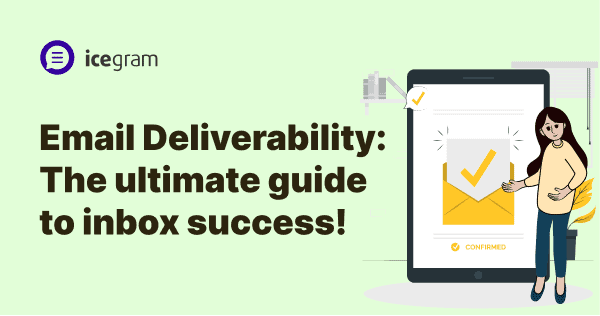From my personal experience in the world of email marketing, I’ve come to realize that the success of any email campaign hinges on one critical factor: email deliverability.
You might have the most captivating content, irresistible offers, and a meticulously segmented audience. But if your emails fail to reach your subscribers’ inboxes, all your efforts go in vain. That’s where email deliverability comes into play.
So, without further ado, let’s unravel the mysteries of email deliverability and unlock the key to reaching your audience effectively. Get ready to decode the secrets that will take your email marketing efforts to new heights!
What is email deliverability and why does it matter?
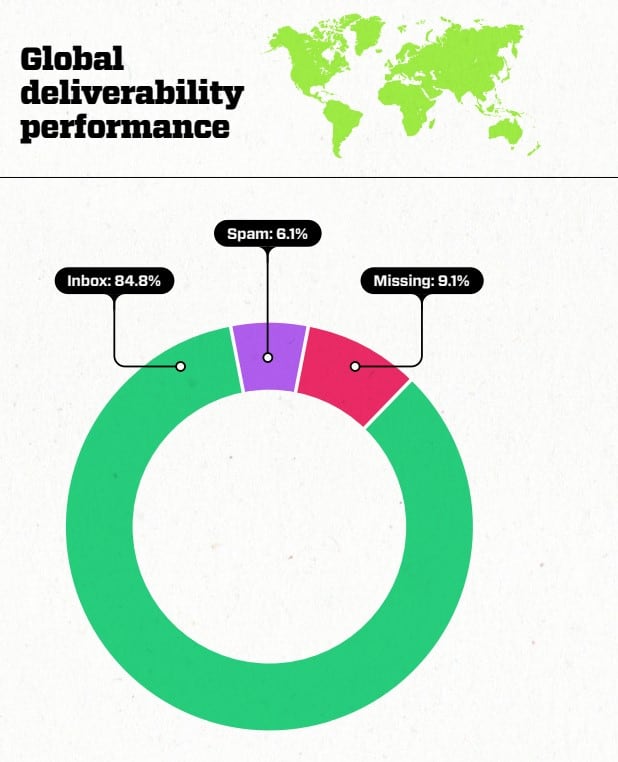
Well, let me share a personal anecdote. In my early days as an email marketer, I naively assumed that once I hit the “Send” button, my job was done. But soon enough, I started noticing disappointing open rates, low click-through rates, and a lack of tangible results.
That’s when I discovered the crucial role that email deliverability plays.
Email deliverability refers to the ability of your emails to land in the intended recipients’ inboxes, rather than getting lost in spam folders or being blocked by stringent filters.
When your emails consistently reach the inbox, you have a higher chance of engaging with your audience, driving conversions, and achieving your marketing goals.
On the other hand, poor deliverability can result in missed opportunities, low engagement, and a significant dent in your campaign’s effectiveness. At its core, email deliverability determines the fate of your marketing endeavours.
Let’s delve deeper into its significance and uncover the underlying reasons for its importance.
Building trust and credibility
In today’s digital landscape, trust is a currency that holds immense value. Email marketing requires trust from your subscribers. Why? Because it leads to engagement, conversions, and long-term customer relationships.
This study found that 77% of consumers prefer to receive permission-based marketing communications through email. Here are some key strategies to build trust and credibility:
- Provide value: Deliver relevant, valuable, and engaging content consistently.
- Be transparent: Clearly communicate intentions, email frequency, content type, and data handling.
- Personalization and segmentation: Tailor emails to individual needs and preferences, leveraging data and segmentation techniques.
Maximizing campaign effectiveness
Email marketing can be a powerful tool for driving results, but only if your campaigns happen to perform, effectively. To maximize the impact of your email campaigns, consider the following strategies:
- Compelling subject lines: Craft attention-grabbing subject lines that engage subscribers’ curiosity and entice them to open your emails. A well-crafted subject line sets the stage for a successful campaign.
- Engaging content: Create compelling and relevant content that resonates with your target audience. From captivating copy to visually appealing designs, your emails should capture attention and encourage action.
- Call-to-Action (CTA): Clearly define the desired action you want subscribers to take. Whether it’s making a purchase, signing up for a webinar, or downloading a resource, include a persuasive CTA that stands out and compels readers to act.
Maintaining a positive sender reputation
Your sender’s reputation is crucial to email deliverability. Internet Service Providers (ISPs) and email filters assess the reputation of your sending domain and IP address to decide whether your emails should reach your inbox or be filtered as spam. To maintain a positive reputation as a sender, follow these tips.
- Consistently engage subscribers: Encourage subscribers to open and interact with your emails by providing valuable content and incentivizing engagement. A healthy engagement rate signals to ISPs that your emails are beneficial and relevant.
- Monitor deliverability metrics: Keep a close eye on key deliverability metrics such as open rates, click-through rates, bounce rates, and spam complaints. Identifying and addressing any issues promptly helps maintain a positive sender reputation.
- Authenticate your emails: Implement email authentication protocols such as SPF (Sender Policy Framework), DKIM (DomainKeys Identified Mail), and DMARC (Domain-based Message Authentication, Reporting, and Conformance). These protocols verify the authenticity of your emails and reduce the chances of flagging them as suspicious or fraudulent.
Additionally, ensuring your email content is relevant and engaging to your subscribers can improve their engagement and help boost your sender’s reputation. By following these best practices, you can improve your email deliverability and ensure your messages reach your intended audience.
Factors affecting deliverability in emails
There are several key factors that determine whether your messages reach recipients’ inboxes. Understanding these factors is essential for optimizing deliverability rates. Let’s explore the primary elements that impact email deliverability:
Email authentication (SPF, DKIM, DMARC)
Email authentication protocols such as SPF (Sender Policy Framework), DKIM (DomainKeys Identified Mail), and DMARC (Domain-based Message Authentication, Reporting, and Conformance) play a crucial role in establishing your emails’ authenticity and trustworthiness.
SPF verifies that the sender is authorized to send emails on behalf of the domain, DKIM adds a digital signature to validate the integrity of the message, and DMARC provides further guidelines and reporting mechanisms to enhance email authentication.
IP reputation and sender score
The reputation of the IP address you send emails from and your sender score are critical factors affecting deliverability. Email service providers and Internet service providers evaluate your IP address’ reputation when deciding whether to deliver your emails or flag them as spam.
Content quality and relevance
The quality and relevance of your email content directly impact deliverability rates. ISPs assess your emails’ content to determine their value to recipients.
High-quality content that provides value, aligns with recipients’ expectations and avoids spam-triggering elements has a better chance of reaching their inboxes.
Crafting compelling, targeted content, can improve engagement, enhance deliverability, and foster stronger connections with your audience.
Subscriber engagement
Recipient engagement is a critical factor that ISPs consider when determining deliverability. High engagement, indicated by actions such as opens, clicks, and replies, signals to ISPs that your emails are valuable and relevant.
Encouraging active subscriber engagement through personalized content, compelling subject lines, and strategic call-to-actions can improve your deliverability rates.
By understanding and addressing these factors, you can optimize your email deliverability and increase the chances of your messages reaching the intended recipients’ inboxes.
Common issues and mistakes in email deliverability
There are common challenges and mistakes that can hinder deliverability and impact campaign success. By understanding and addressing these issues, you can improve email deliverability rates and results. Let’s explore some common issues and mistakes.
Spam filters and their impact
Spam filters are an essential line of defense against unwanted or malicious emails. However, they flag legitimate emails as spam, leading to deliverability issues. According to a report by GlockApps, approximately 20% of legitimate marketing emails fail to reach the inbox due to overactive spam filters.
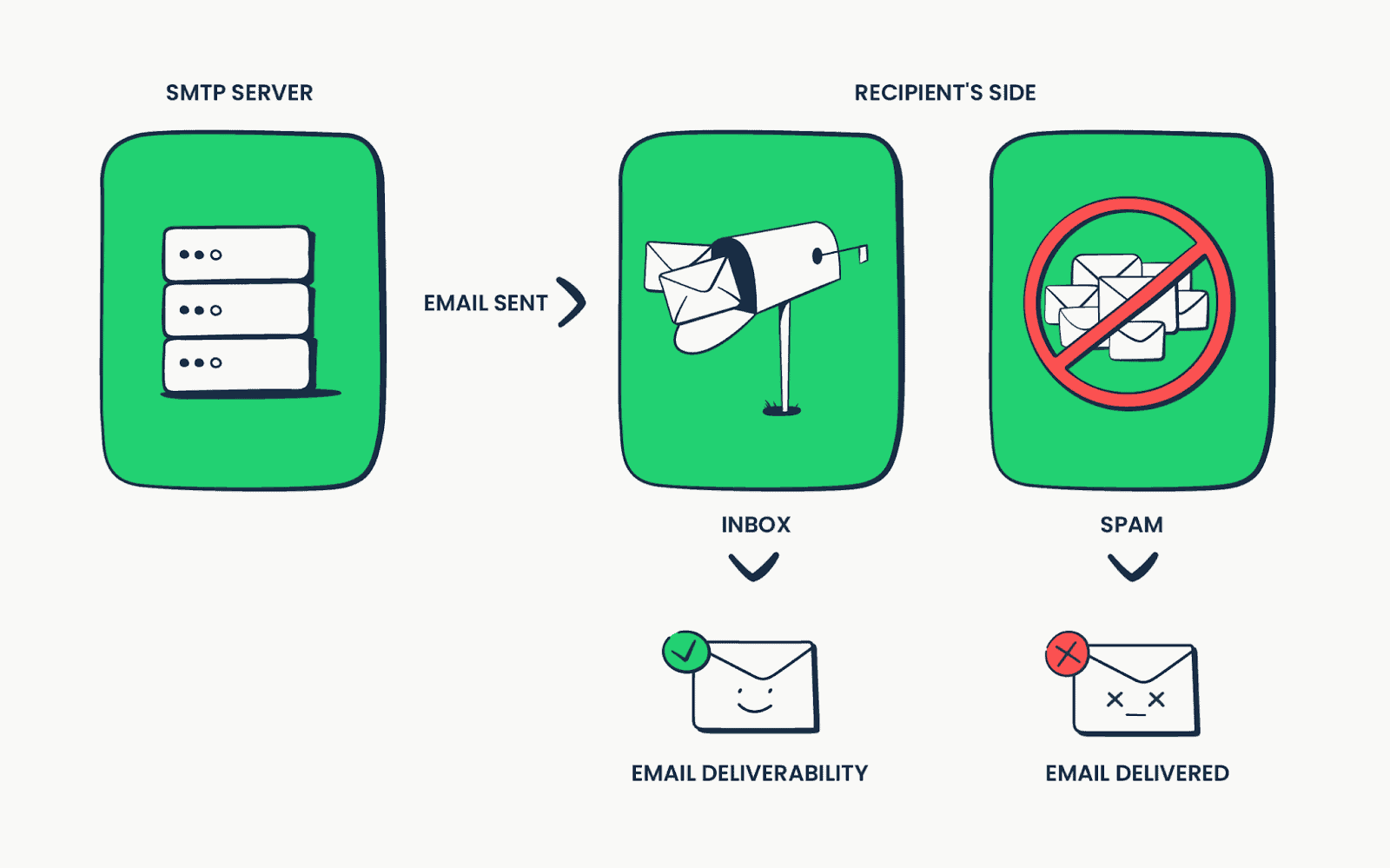
To mitigate spam filters, follow best practices. These include avoiding spam trigger words, maintaining a positive sender reputation, and monitoring your email content for red flags. Regularly test your emails using deliverability tools and conduct thorough spam filter testing to ensure optimal inbox placement.
High bounce rates and their causes
High bounce rates can negatively impact deliverability and indicate issues with your email list or sending practices. The average bounce rate for marketing emails is around 2.1%. Bounces can be classified as soft bounces (temporary) or hard bounces (permanent).
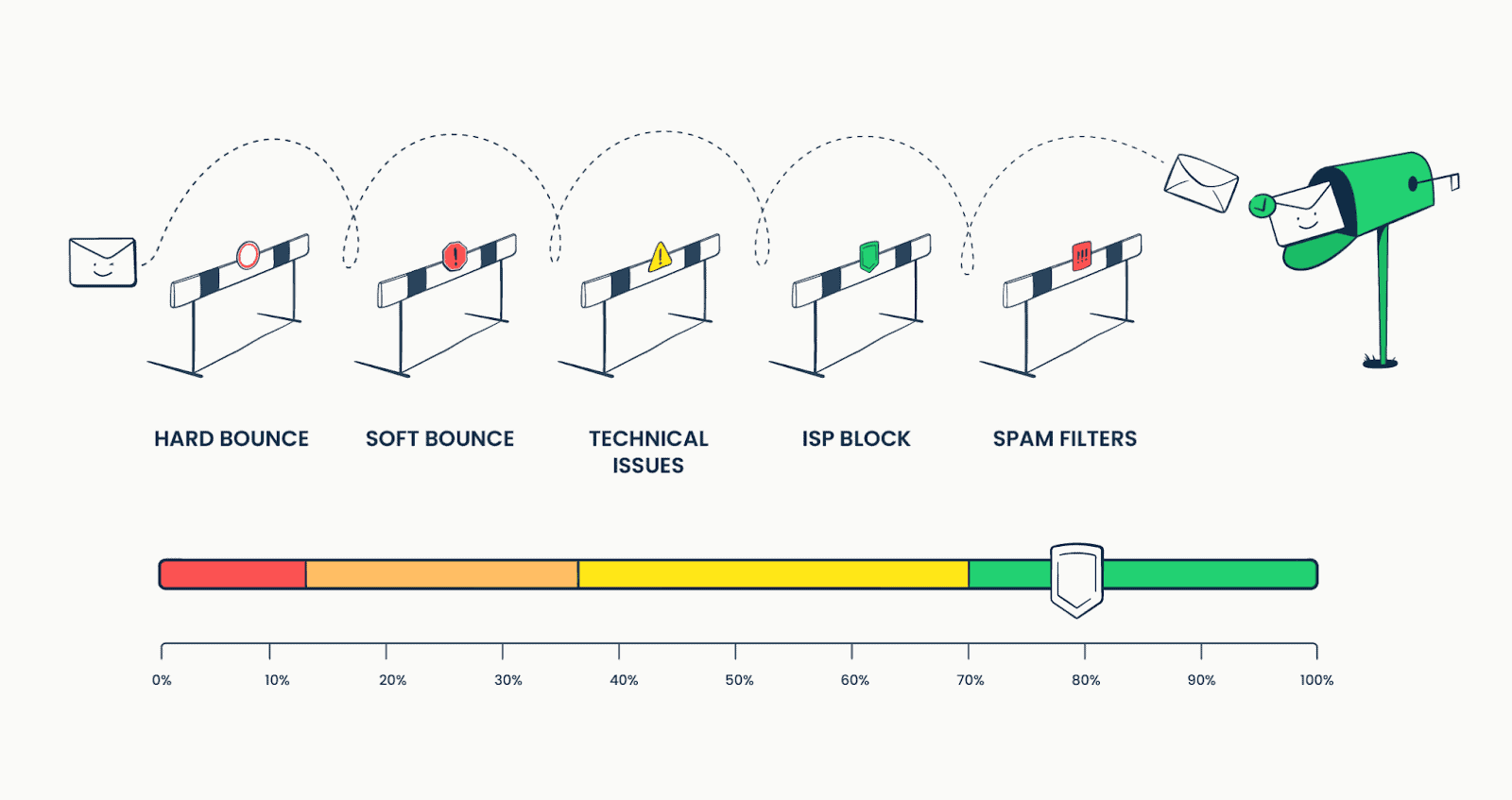
Soft bounces are often caused by full mailboxes or temporary server issues, while hard bounces result from invalid or non-existent email addresses. To reduce bounce rates, maintain a clean email list by regularly removing invalid addresses, monitor bounce notifications, and promptly address any delivery failures.
Unsubscribes and complaints
Getting unsubscribed and getting complaints can have a negative impact on the sender’s reputation and deliverability. According to a Mailmodo study, the average unsubscribe rate across industries is 0.19%.
Complaint rates, which measure the number of recipients marking emails as spam, vary but should be kept below 0.1%.

To minimize unsubscribes and complaints, provide clear and easy-to-find unsubscribe options in your emails, honour unsubscribe requests promptly, and ensure your email content remains relevant and engaging.
Monitor feedback and address subscriber concerns or complaints to maintain a positive sender reputation.
Blacklisting and deliverability fallout
Being blacklisted by ISPs or spam monitoring organizations can severely affect email deliverability. According to the 2023 Email Deliverability Benchmark Report by Validity, the average global blacklisting rate is 6.5%.
To avoid blacklisting, it’s essential to maintain a strong sender reputation by adhering to email best practices. This includes respecting subscriber consent and promptly addressing issues or complaints.
Regularly monitor blacklisting databases, implement proper authentication (SPF, DKIM, DMARC), and promptly resolve any deliverability issues to prevent potential blacklisting fallout.
By addressing these common issues and avoiding the mistakes listed above, you can improve your email deliverability rates. You can also maintain a positive sender reputation, and increase email marketing effectiveness.
Steps to ensure strong email deliverability
Deliverability plays a crucial role in the success of your email marketing campaigns. To maximize your chances of reaching the inbox and engaging with your audience, it’s important to follow these steps:
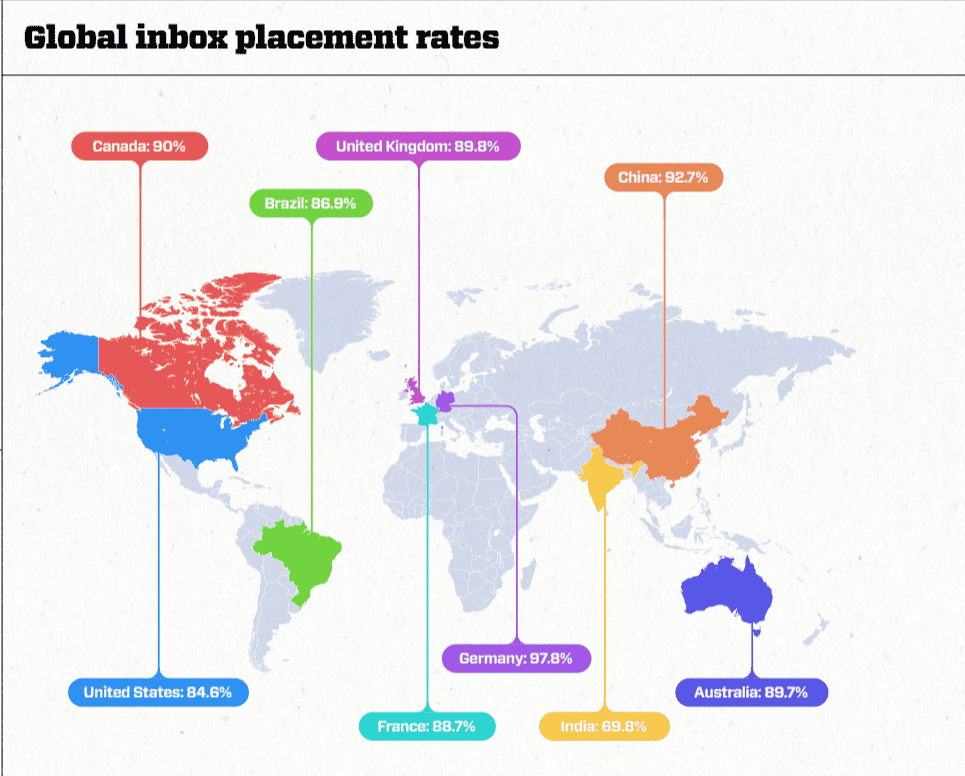
Building a high-quality email list:
A high-quality email list consists of engaged subscribers who have opted in to receive your emails. It’s essential to focus on quality over quantity. According to a study by Bloomreach, marketers reported a 28% increase in open rates and a 33% increase in click-through rates when using permission-based lists.
To build a high-quality list, employ permission-based opt-in strategies, such as double opt-in or confirmed opt-ins. This ensures that subscribers genuinely want to receive your emails and reduces the likelihood of spam complaints and unsubscribes.
Regularly review and maintain your list, removing inactive or unengaged subscribers.
Email authentication and configuration
The establishment of trust and the improvement of deliverability depends on Email Authentication Protocols. These protocols verify the authenticity of your emails and protect against spoofing and phishing attempts.
Proper email server configuration is also important. Configure your server to comply with industry standards, including proper DNS settings and reverse DNS lookup. This ensures that your emails are sent from a trusted and authenticated source.
Crafting engaging and relevant content
Engaging and relevant content is key to capturing the attention and interest of your subscribers. Personalization, segmentation, and A/B testing are effective strategies to enhance engagement. Personalized emails deliver six times higher transaction rates compared to non-personalized emails.
Consider plugins like Icegram Express to create visually appealing emails with dynamic content. Icegram Express offers a range of customizable templates and drag-and-drop functionality, allowing you to easily create engaging email campaigns that resonate with your audience.
Monitoring and analyzing performance
Regularly monitor and analyze key performance metrics to gauge the effectiveness of your email campaigns. Track deliverability metrics, open rates, click-through rates, bounce rates, and unsubscribe rates.
This data provides insights into the success of your strategies and helps identify areas for improvement.
Use email analytics tools provided by your email service provider or third-party solutions to gain in-depth insights.
Managing complaints and unsubscribes
Providing clear and easy-to-find unsubscribe options is essential for compliance and maintaining a positive sender reputation. Subscribers are less likely to mark their emails as spam if you offer a simple one-click unsubscribe option.
Additionally, promptly address subscriber complaints and feedback. Actively monitor and respond to inquiries or concerns to build trust and foster positive relationships with your audience.
Maintaining sender reputation
Maintaining a strong sender reputation is crucial for email deliverability. Regularly check blacklisting databases to ensure your IP or domain is not listed.
Resolve any deliverability issues promptly. Implement best practices, adhere to email guidelines, and promptly address any issues that may affect your sender’s reputation. Building a positive reputation takes time and effort, but it is vital for long-term deliverability success.
By following these steps, plugins like Icegram Express, and referring to industry resources, you can enhance your email deliverability, engage your audience effectively, and
Conclusion
To maximize your email campaign success, master deliverability. Build a quality email list, implement authentication protocols, and craft engaging content. Stay updated with best practices for compliance. Monitor metrics, leverage analytics tools, and optimize performance with data-driven decisions.
Forge connections, witness growth, and achieve unparalleled success in your email marketing journey. Plugins like Icegram Express can be instrumental in creating visually appealing emails and engaging your subscribers effectively. Prioritize trust, relevance, and sender reputation to cultivate meaningful connections with your subscribers.
Embrace the power of email deliverability and unlock the full potential of your campaigns. Remember, your emails matter, and so does their deliverability.

